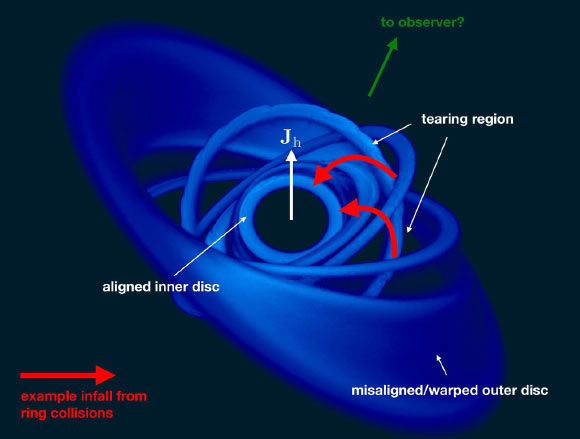University of Leicester’s Professor Ken Pounds and co-authors report the detection of matter falling into a black hole at 30% of the speed of light.

This image shows the Seyfert galaxy PG1211+143. Image credit: Centre de Données astronomiques de Strasbourg / SIMBAD / SDSS.
It is now well established that a supermassive black hole lies in the center of most galaxies, and further that it accretes matter through a disk.
With sufficient matter (interstellar gas clouds or even isolated stars) falling into the black hole, these can become extremely luminous, and are seen as a quasar or active galactic nucleus (AGN).
The orbit of matter around the black hole is often assumed to be aligned with the rotation of the black hole, but there is no compelling reason for this to be the case. In fact, the reason we have summer and winter is that the Earth’s daily rotation does not line up with its yearly orbit around the Sun.
Until now it has been unclear how misaligned rotation might affect the in-fall of matter. This is particularly relevant to the feeding of supermassive black holes since matter can fall in from any direction.
Using data from ESA’s XMM-Newton X-ray Observatory, Professor Pounds and colleagues looked at X-ray spectra from PG1211+143, a Seyfert galaxy (characterized by a very bright AGN resulting from the presence of the massive black hole at its nucleus) located in the constellation Coma Berenices, about one billion light-years away.

Characteristic disk structure from the simulation of a misaligned disk around a spinning black hole. The outermost regions are warped and remain misaligned. Inside this, several rings have broken free and are freely precessing through the Lense-Thirring effect. The innermost material has fallen from the shocks that occur between rings, and is aligned to the central black hole spin (it is the misaligned component of angular momentum that is cancelled in the shocks – and transferred to the hole through precession). Depending on the observer’s line of sight, the infalling matter may or may not obscure the central emitting regions. Note that the black hole spin vector is drawn as an arrow up the page, but this is the projection on to the page. The black hole spin vector points out towards the reader as well as in the direction drawn, such that the vector is normal to the innermost ring of gas. Image credit: K.A. Pounds et al / University of Leicester.
The team found the spectra to be strongly red-shifted, showing the observed matter to be falling into PG1211+143’s black hole at the enormous speed of 30% of the speed of light, or around 62,000 miles per second (100,000 km per second).
The gas has almost no rotation around the black hole, and is detected extremely close to it in astronomical terms, at a distance of only 20 times the black hole’s size (its event horizon, the boundary of the region where escape is no longer possible).
“The galaxy we were observing with XMM-Newton has a 40-million-solar-mass black hole which is very bright and evidently well fed,” Professor Pounds said.
“Indeed some 15 years ago we detected a powerful wind indicating the black hole was being over-fed. While such winds are now found in many active galaxies, PG1211+143 has now yielded another ‘first,’ with the detection of matter plunging directly into the black hole itself.”
“We were able to follow an Earth-sized clump of matter for about a day, as it was pulled towards the black hole, accelerating to a third of the velocity of light before being swallowed up by the hole.”
The results appear in the Monthly Notices of the Royal Astronomical Society.
_____
K.A. Pounds et al .2018. An ultrafast inflow in the luminous Seyfert PG1211+143. MNRAS 481 (2): 1832-1838; doi: 10.1093/mnras/sty2359







